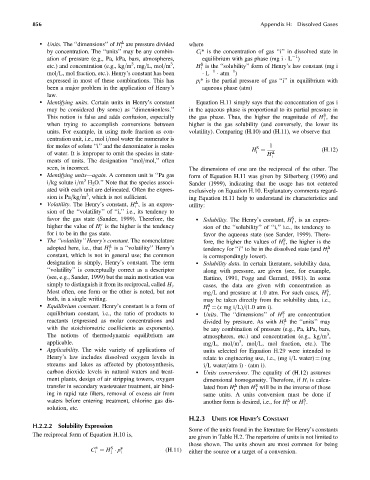Page 901 - Fundamentals of Water Treatment Unit Processes : Physical, Chemical, and Biological
P. 901
856 Appendix H: Dissolved Gases
D
. Units. The ‘‘dimensions’’ of H are pressure divided where
i
by concentration. The ‘‘units’’ may be any combin- C i * is the concentration of gas ‘‘i’’ in dissolved state in
1
ation of pressure (e.g., Pa, kPa, bars, atmospheres, equilibrium with gas phase (mg i L )
S
3
3
etc.) and concentration (e.g., kg=m ,mg=L, mol=m , H is the ‘‘solubility’’ form of Henry’s law constant (mg i
1
1
mol=L, mol fraction, etc.). Henry’s constant has been L 1 atm )
expressed in most of these combinations. This has p i * is the partial pressure of gas ‘‘i’’ in equilibrium with
been a major problem in the application of Henry’s aqueous phase (atm)
law.
. Identifying units. Certain units in Henry’s constant Equation H.11 simply says that the concentration of gas i
may be considered (by some) as ‘‘dimensionless.’’ in the aqueous phase is proportional to its partial pressure in
S
This notion is false and adds confusion, especially the gas phase. Thus, the higher the magnitude of H , the
1
when trying to accomplish conversions between higher is the gas solubility (and conversely, the lower its
units. For example, in using mole fraction as con- volatility). Comparing (H.10) and (H.11), we observe that
centration unit, i.e., mol i=mol water the numerator is
for moles of solute ‘‘i’’ and the denominator is moles S 1 (H:12)
i
of water. It is improper to omit the species in state- H ¼ H D
i
ments of units. The designation ‘‘mol=mol,’’ often
seen, is incorrect. The dimensions of one are the reciprocal of the other. The
. Identifying units—again. A common unit is ‘‘Pa gas
form of Equation H.11 was given by Silberberg (1996) and
3
i=kg solute i=m H 2 O.’’ Note that the species associ- Sander (1999), indicating that the usage has not centered
ated with each unit are delineated. Often the expres- exclusively on Equation H.10. Explanatory comments regard-
3
sion is Pa=kg=m , which is not sufficient. ing Equation H.11 help to understand its characteristics and
D
. Volatility. The Henry’s constant, H , is an expres-
i utility:
sion of the ‘‘volatility’’ of ‘‘i,’’ i.e., its tendency to
favor the gas state (Sander, 1999). Therefore, the . Solubility. The Henry’s constant, H , is an expres-
S
1
higher the value of H is the higher is the tendency sion of the ‘‘solubility’’ of ‘‘i,’’ i.e., its tendency to
i
for i to be in the gas state. favor the aqueous state (see Sander, 1999). There-
. The ‘‘volatility’’ Henry’s constant. The nomenclature fore, the higher the values of H , the higher is the
S
1
D
adopted here, i.e., that H is a ‘‘volatility’’ Henry’s D
i tendency for ‘‘i’’ to be in the dissolved state (and H i
constant, which is not in general use; the common is correspondingly lower).
designation is simply, Henry’s constant. The term . Solubility data. In certain literature, solubility data,
‘‘volatility’’ is conceptually correct as a descriptor along with pressure, are given (see, for example,
(see, e.g., Sander, 1999) but the main motivation was Battino, 1991, Fogg and Gerrard, 1981). In some
simply to distinguish it from its reciprocal, called H i . cases, the data are given with concentration as
Most often, one form or the other is noted, but not mg=L and pressure at 1.0 atm. For such cases, H ,
S
1
both, in a single writing. may be taken directly from the solubility data, i.e.,
. Equilibrium constant. Henry’s constant is a form of S
H ¼ (x mg i=L)=(1.0 atm i).
1
equilibrium constant, i.e., the ratio of products to . Units. The ‘‘dimensions’’ of H are concentration
S
1
reactants (expressed as molar concentrations and divided by pressure. As with H the ‘‘units’’ may
D
i
with the stoichiometric coefficients as exponents). be any combination of pressure (e.g., Pa, kPa, bars,
The notions of thermodynamic equilibrium are atmospheres, etc.) and concentration (e.g., kg=m ,
3
applicable. mg=L, mol=m , mol=L, mol fraction, etc.). The
3
. Applicability. The wide variety of applications of
units selected for Equation H.29 were intended to
Henry’s law includes dissolved oxygen levels in relate to engineering use, i.e., (mg i=L water) ¼ (mg
streams and lakes as affected by photosynthesis, i=L water=atm i) (atm i).
carbon dioxide levels in natural waters and treat- . Units conversions. The equality of (H.12) assumes
ment plants, design of air stripping towers, oxygen dimensional homogeneity. Therefore, if H i is calcu-
transfer in secondary wastewater treatment, air bind- lated from H then H will be in the inverse of those
D
S
i 1
ing in rapid rate filters, removal of excess air from same units. A units conversion must be done if
D
S
waters before entering treatment, chlorine gas dis- another form is desired, i.e., for H or H .
i 1
solution, etc.
H.2.3 UNITS FOR HENRY’S CONSTANT
H.2.2.2 Solubility Expression
Some of the units found in the literature for Henry’s constants
The reciprocal form of Equation H.10 is,
are given in Table H.2. The repertoire of units is not limited to
those shown. The units shown are most common for being
S
*
C i ¼ H p* (H:11)
1 i either the source or a target of a conversion.

